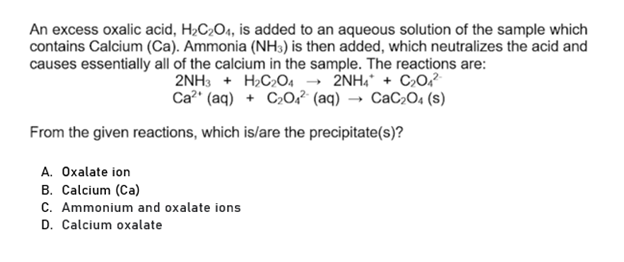An excess oxalic acid, H2C¿O4, is added to an aqueous solution of the sample which contains Calcium (Ca). Ammonia (NH3) is then added, which neutralizes the acid and causes essentially all of the calcium in the sample. The reactions are: 2NH3 + H2CO4 2NH, + C0? Ca?" (aq) + C20? (aq) → CaC,O, (s) From the given reactions, which is/are the precipitate(s)? A. Oxalate ion B. Calcium (Ca) C. Ammonium and oxalate ions D. Calcium oxalate
An excess oxalic acid, H2C¿O4, is added to an aqueous solution of the sample which contains Calcium (Ca). Ammonia (NH3) is then added, which neutralizes the acid and causes essentially all of the calcium in the sample. The reactions are: 2NH3 + H2CO4 2NH, + C0? Ca?" (aq) + C20? (aq) → CaC,O, (s) From the given reactions, which is/are the precipitate(s)? A. Oxalate ion B. Calcium (Ca) C. Ammonium and oxalate ions D. Calcium oxalate
Introduction to General, Organic and Biochemistry
11th Edition
ISBN:9781285869759
Author:Frederick A. Bettelheim, William H. Brown, Mary K. Campbell, Shawn O. Farrell, Omar Torres
Publisher:Frederick A. Bettelheim, William H. Brown, Mary K. Campbell, Shawn O. Farrell, Omar Torres
Chapter4: Chemical Reactions
Section: Chapter Questions
Problem 4.20P: 4-20 Calcium oxide is prepared by heating limestone (calcium carbonate, CaCO3) to a high...
Related questions
Question
3. Please provide detailed explanation.

Transcribed Image Text:An excess oxalic acid, H2C2O4, is added to an aqueous solution of the sample which
contains Calcium (Ca). Ammonia (NH3) is then added, which neutralizes the acid and
causes essentially all of the calcium in the sample. The reactions are:
2NH3 + H2C2O4 → 2NH, + C20,?
Ca?" (aq) + C»0,² (aq) → CaC,O, (s)
From the given reactions, which is/are the precipitate(s)?
A. Oxalate ion
B. Calcium (Ca)
C. Ammonium and oxalate ions
D. Calcium oxalate
Expert Solution
This question has been solved!
Explore an expertly crafted, step-by-step solution for a thorough understanding of key concepts.
This is a popular solution!
Trending now
This is a popular solution!
Step by step
Solved in 2 steps

Knowledge Booster
Learn more about
Need a deep-dive on the concept behind this application? Look no further. Learn more about this topic, chemistry and related others by exploring similar questions and additional content below.Recommended textbooks for you

Introduction to General, Organic and Biochemistry
Chemistry
ISBN:
9781285869759
Author:
Frederick A. Bettelheim, William H. Brown, Mary K. Campbell, Shawn O. Farrell, Omar Torres
Publisher:
Cengage Learning

Introductory Chemistry: A Foundation
Chemistry
ISBN:
9781337399425
Author:
Steven S. Zumdahl, Donald J. DeCoste
Publisher:
Cengage Learning

Chemistry for Engineering Students
Chemistry
ISBN:
9781337398909
Author:
Lawrence S. Brown, Tom Holme
Publisher:
Cengage Learning

Introduction to General, Organic and Biochemistry
Chemistry
ISBN:
9781285869759
Author:
Frederick A. Bettelheim, William H. Brown, Mary K. Campbell, Shawn O. Farrell, Omar Torres
Publisher:
Cengage Learning

Introductory Chemistry: A Foundation
Chemistry
ISBN:
9781337399425
Author:
Steven S. Zumdahl, Donald J. DeCoste
Publisher:
Cengage Learning

Chemistry for Engineering Students
Chemistry
ISBN:
9781337398909
Author:
Lawrence S. Brown, Tom Holme
Publisher:
Cengage Learning

Chemistry
Chemistry
ISBN:
9781305957404
Author:
Steven S. Zumdahl, Susan A. Zumdahl, Donald J. DeCoste
Publisher:
Cengage Learning

World of Chemistry, 3rd edition
Chemistry
ISBN:
9781133109655
Author:
Steven S. Zumdahl, Susan L. Zumdahl, Donald J. DeCoste
Publisher:
Brooks / Cole / Cengage Learning

Principles of Modern Chemistry
Chemistry
ISBN:
9781305079113
Author:
David W. Oxtoby, H. Pat Gillis, Laurie J. Butler
Publisher:
Cengage Learning